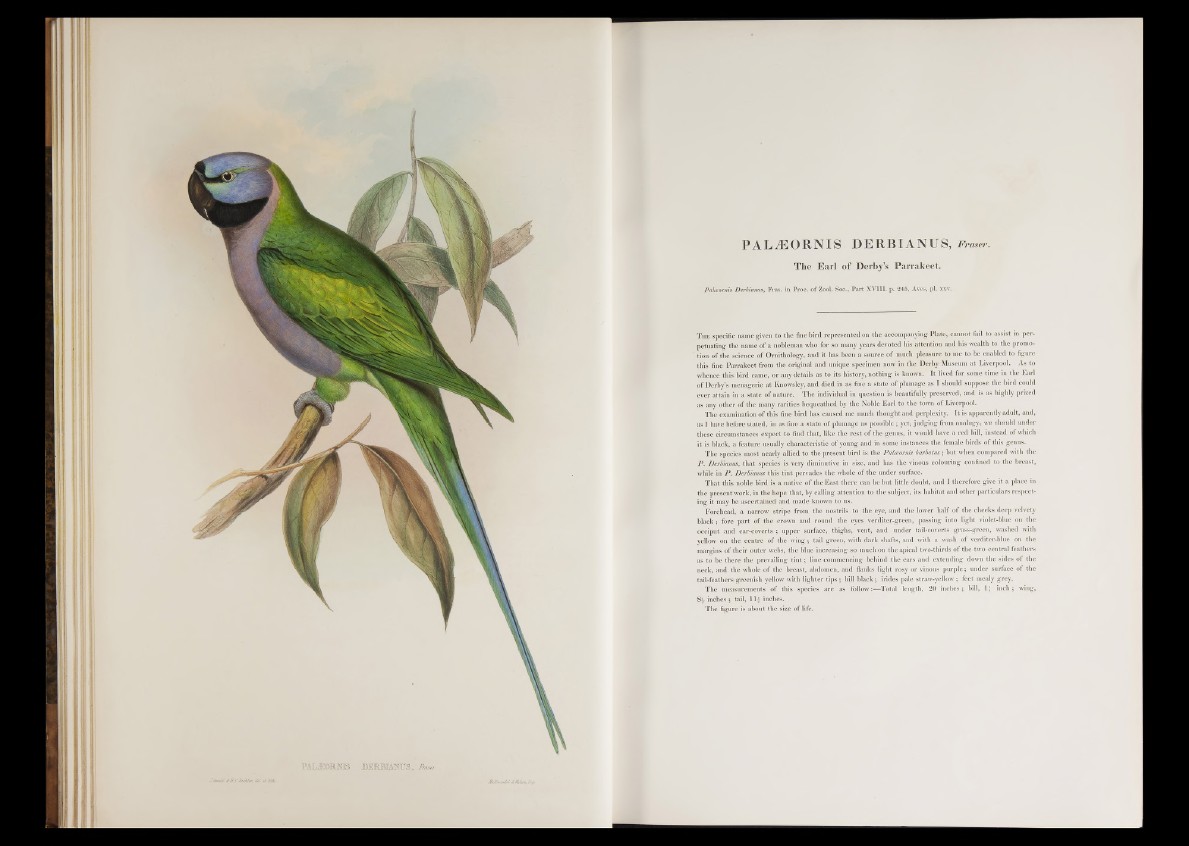
EÄIJECMMIS MERMAHÜS, M m-
J.Grucd. iS C.lbiehier, del ei àii-.
PALÆORNIS DERBIANUS , Fraser.
The Earl of Derby’s Parrakeet.
Pakeornis Derbianus, Fras. in Proc. o f Zool. Soc., Part XVIII. p. 245, Aves, pl. xxv.
T he specific name given to the fine bird represented on the accompanying Plate, cannot fail to assist in perpetuating
the name of a nobleman who for so many years devoted his attention and his wealth to the promotion
of the science o f Ornithology, and it has been a source o f much pleasure to me to be enabled to figure
this fine Parrakeet from the original and unique specimen now in the Derby Museum at Liverpool. As to
whence this bird came, or any details as to its history, nothing is known. It lived for some time in the Earl
of Derby’s menagerie at Knowsley, and died in as fine a state of plumage as I should suppose the bird could
ever attain in a state of nature. The individual in question is beautifully preserved, and is as highly prized
as any other of the many rarities bequeathed by the Noble Earl to the town of Liverpool.
The examination of this fine bird has caused me much thought and perplexity. It is apparently adult, and,
as I have before stated, in as fine a state of plumage as possible; yet, judging from analogy, we should under
these circumstances expect to find that, like the rest of the genus, it would have a red bill, instead of which
it is black, a feature usually characteristic of young and in some instances the female birds of this genus.
The species most nearly allied to the present bird is the Palceornis barbatus; but when compared with the
P . Derbianus, that species is very diminutive in size, and has the vinous colouring confined to the breast,
while in P . Derbianus this tint pervades the whole of the under surface.
That this noble bird is a native o f the East there can be but little doubt, and I therefore give it a place in
the present work, in the hope that, by calling attention to the subject, its habitat and other particulars respecting
it may be ascertained and made known to us.
Forehead, a narrow stripe from the nostrils to the eye, and the lower half of the cheeks deep velvety
black ; fore part of the crown and round the eyes verditer-green, passing into light violet-blue on the
occiput and ear-coverts ; upper surface, thighs, vent, and under tail-coverts grass-green, washed with
yellow on the centre of the wing; tail green, with dark shafts, and with a wash of verditer-blue on the
margins of their outer webs, the blue increasing so much on the apical two-thirds o f the two central feathers
as to be there the prevailing tin t; line commencing behind the ears and extending down the sides of the
neck, and the whole of the breast, abdomen, and flanks light rosy or vinous purple; under surface of the
tail-feathers greenish yellow with lighter tips; bill black; irides pale straw-yellow ; feet mealy grey.
The measurements of this species are as follow:—Total length, 20 inches; bill, 1 i inch; wing,
inches ; tail, 1 inches.
The figure is about the size of life.